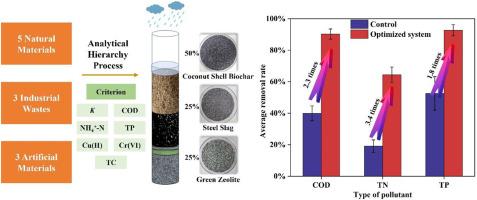Efficiently optimized multi-fillers for rain gardens: Long-term pollution control performance
IF 8.7
Q1 Environmental Science
引用次数: 0
Abstract
Rain gardens play a pivotal role in the infiltration and purification of runoff, with the filler layer being a critical component. However, the selection and configuration of fillers in existing rain gardens often lack scientific rigor, leading to suboptimal performance. To address this issue, this study employs the Analytic Hierarchy Process (AHP) to systematically evaluate 11 types of fillers, including 5 natural materials, 3 industrial wastes, and 3 artificial materials, aiming to optimize filler configurations and enhance the pollutant removal efficiency of rain gardens. The results demonstrate that steel slag, coconut shell biochar, green zeolite, and fly ash ceramic granules exhibit superior performance in purifying both simulated and actual runoff. The optimal filler combination, comprising 25% green zeolite, 25% steel slag, and 50% coconut shell biochar, achieved removal rates of 50.49%, 76.12%, 44.12%, 89.94%, 58.38%, and 88.19% for COD, NH4+-N, TP, Cu(II), Cr(VI), and tetracycline, respectively. Long-term operational evaluation (>110 days) revealed that the optimized filler layer significantly improved the removal rates of COD, TN, and TP to 86.83%, 80.19%, and 88.42%, respectively. By comparing the physicochemical properties of the fillers before and after use, the mechanisms underlying runoff purification were preliminarily elucidated. Different fillers exhibited specific adsorption capabilities for distinct pollutants, and the synergistic effects of multiple fillers significantly enhanced the rain garden's capacity for source pollutant reduction. AHP was used in this study to validate the scientific validity of AHP in the device of rain gardens through filler combination adsorption experiments and long-term monitoring of rain garden installations, while concurrently offering a broader range of green solutions for the enhancement of rain gardens.

高效优化的雨水花园多填料:长期污染控制性能
雨水花园在径流的入渗和净化中起着关键作用,其中填料层是一个关键组成部分。然而,在现有的雨水花园中,填料的选择和配置往往缺乏科学的严谨性,导致性能不佳。针对这一问题,本研究采用层次分析法(AHP)对5种天然材料、3种工业废弃物、3种人工材料等11种填料进行了系统评价,旨在优化填料配置,提高雨园的污染物去除效率。结果表明,钢渣、椰壳生物炭、绿色沸石和粉煤灰陶瓷颗粒对模拟径流和实际径流均有较好的净化效果。最佳填料组合为25%绿沸石、25%钢渣、50%椰壳生物炭,对COD、NH4+-N、TP、Cu(II)、Cr(VI)和四环素的去除率分别为50.49%、76.12%、44.12%、89.94%、58.38%和88.19%。长期运行评价(>110 d)表明,优化后的填料层对COD、TN和TP的去除率分别达到86.83%、80.19%和88.42%。通过对填料使用前后理化性能的比较,初步探讨了填料净化径流的机理。不同填料对不同污染物表现出特定的吸附能力,多种填料的协同效应显著增强了雨园对源污染物的减排能力。本研究采用层次分析法,通过填料组合吸附实验和对雨园装置的长期监测,验证层次分析法在雨园装置中的科学有效性,同时为雨园的提升提供更广泛的绿色解决方案。
本文章由计算机程序翻译,如有差异,请以英文原文为准。
求助全文
约1分钟内获得全文
求助全文
来源期刊

Water Cycle
Engineering-Engineering (miscellaneous)
CiteScore
9.20
自引率
0.00%
发文量
20
审稿时长
45 days
 求助内容:
求助内容: 应助结果提醒方式:
应助结果提醒方式:


